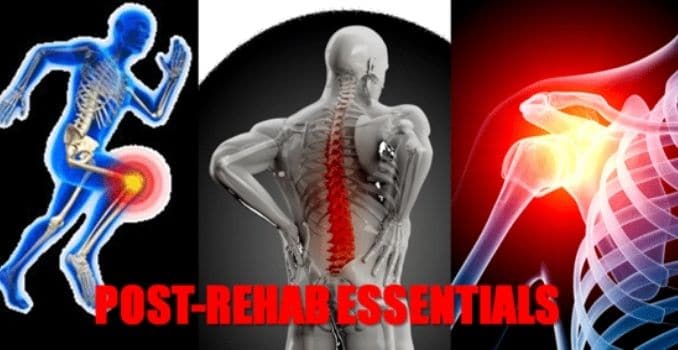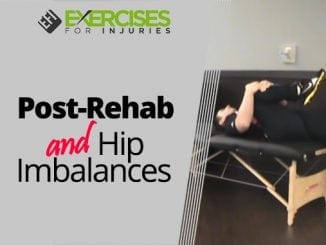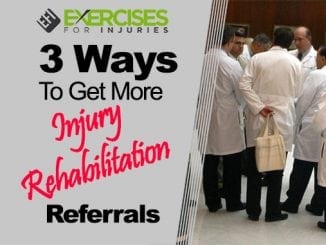
As you know, I am an injury guy. I got a great Q and A for you today. It is on the vital topic of Post-Rehab.
A huge trend that I am seeing is more and more people going into the gym, recreation center, studios, home training, and boot camps with previous injuries.
If you don’t believe me that injuries are a big deal, have a look at this:
Injuries and overuse syndromes in powerlifting.
- 43.3% of powerlifters complain of problems during their routine workouts
- Injury rates were calculated at 0.3 injuries per lifter per year – or 1000 hours of training equaled one injury
- The most common areas injured were the shoulder, lower back, and knee (No surprise)
- Use of weight belts increased the injury rate of the lumbar spine (WoW!)
- Upper body injuries increase with age and gender (female)
Okay, I am not a powerlifter. You may not be a powerlifter either.
These people lift heavy stuff and train hard, which can lead to injuries, but for them to lift for an extended period, they have to have good technique.
Let’s look at regular people and the issues they have.
Shoulder injuries attributed to resistance training.
- 45 million Americans engage in strength training regularly (that is a lot of people.)
- For those that do resistance training, the shoulder complex is the most common area of injuries (interesting)
- The researchers found that intrinsic risk factors such as joint and muscle imbalances and extrinsic risk factors like improper exercise technique lead to most injuries in the shoulder (suitable old muscle imbalances.)
Fascinating, engaging, interesting. To sum it up, there is a good chance we will train someone with an injury, and we need to know what to do about it.
To get a little more info on post-rehab, I reached out to my friend, Dean Somerset, to chat about post-rehab and what health & fitness professionals need to know about it.
Rick – Let people know a little about you.
Dean – I’m a kinesiologist in Edmonton, Alberta, and I’ve built a practice around the gap between rehabilitation in the classic sense and gym-based workouts.
Most patients will be discharged from physiotherapy or chiropractic and still need to build strength, More than a decade ago, I started working with over 100 allied health care professionals in my city who refer patients to me for post-rehabilitation care or refer clients to me if they think a problem is more complex than a tight muscle or a weak muscle. I provide continuing education programs, including the Post-Rehabilitation workshop.
This is the first exposure a lot of trainers have to any concepts involving injury, what to do with them and what not to do to get them more robust and not risk re-injury.
Post-Rehab and the Trainer
In addition to training clients, teaching other trainers how to improve results allows them to build a larger client base and prevent and treat common injuries, thereby increasing the value of their services to their clients, their potential clients, and our company as well.
Dean’s Story of Post-Rehab
As a competitive athlete, I injured myself frequently, so I spent a lot of time in physiotherapy, chiropractic offices, and doctor’s offices. When I asked, ‘What should I do next?’ there was often no answer. I made a lot of mistakes as I experimented and researched to create a successful treatment method for a variety of ailments and injuries. At Post-rehab, I worked with over 1,000 patients to refine my method.
Here is a clip from Dean’s presentation from MIRU:
Rick – What is “Post-Rehab”?
Dean – Post-Rehab is the gap that exists from the time a patient is discharged from their treatments until the time they could be considered to have a complete recovery from their injuries. Many clinicians will release when the person is:
- able to return to work
- when their insurance runs out
- when their insurance company deems they are ready
They are not necessarily discharged when the person is physically capable of preventing their injury from coming back. As a result, many people with recurrent injuries weren’t appropriately addressed in the first incidence and had to go through further rehab.
A Post-Rehab Example
I recently started working with a client who was discharged from physio in 2010 after breaking his ankle and tearing his rotator cuff. He wanted to play recreational hockey and roughhouse with his kids without feeling like the tin man, but he still had a noticeable limp, severe foot pain, and limited shoulder mobility. He was worried that if he put on the skates, he wouldn’t survive the second period without serious issues, and the first flying body slam would send him to the ER. To prevent this, we had to prepare him. He skates three days a week without difficulty now, and his shoulders haven’t had any issues since he started.
Post-Rehab is also about helping those with long-standing injuries who don’t necessarily fit nicely into the mix of the “average” population. Because nearly half of people over 60 show evidence of rotator cuff tears on MRIs, you could say that if you train anyone over the age of 50, you would need to be proficient in managing shoulder injuries.
Musculoskeletal problems such as spinal injuries or knee injuries are also treated. I’ve been injured for years, and I didn’t know whether my spine would buckle or whether I could become strong without risking my life or finding out whether physiotherapy stopped or started. This series helps keep things simple and helps trainers get off to a good start in helping people.
Here is a clip from Dean’s Post Rehab Essentials course:
Rick – Why is it essential for a fitness professional to know about post-rehab?
Dean – Post-Rehab training services will be the next wave for fitness professionals to capitalize on as the population continues to age.
Trainers who know how to work with post-rehab clients will be able to work with a broader array of clients and through a more significant portion of the wellness continuum.
To put it another way, if your clients get injured, and you can’t work with them, you’re out of business. This will help keep you in business and keep your clients in the game.
This has nothing to do with post-rehab or injuries, but it is a hilarious video:
Rick – From talking and teaching fitness professionals, what common mistakes or misconceptions do they have about post-rehab?
Dean – Aside from thinking they’re fragile little birds who can only do tubing exercises and walk on the treadmill, some of the biggies would be the biomechanical components that go into an injury development pattern.
When a client says their shoulders are sore, doing side raises and military presses will only make them worse sooner than Kim Kardashian files for divorce. They are trying to give everyone exercise, even if it doesn’t help them develop their shoulders or hips in a certain way. We determine which areas are tight, have weak balance, have limited internal rotation, or have a flexion bias in our videos, and then we create exercise programs based on those findings. Medicine and exercise are both effective if they are administered correctly.
Thanks so much, Dean.
Dean has come a long way since I met him at a conference in Edmonton a few years back.
It is excellent that he is sharing more of what he does with fitness professionals worldwide.
Dean has recorded the course he teaches for trainers in his company on Post-Rehab. It is awesome. I am still going through it, but I pick up some great tips.
If you are a fitness professional and would like to know better what to do with a client with an injury, I would highly recommend Dean’s Post-Rehab Essentials course.
Rick Kaselj, MS






